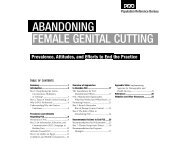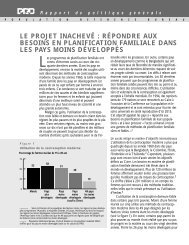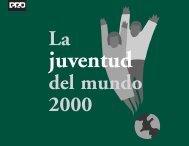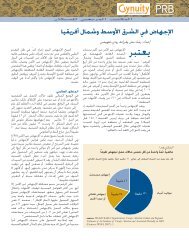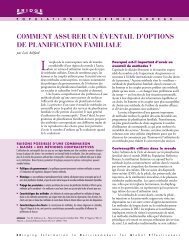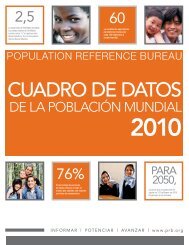Immigration Shaping America - Population Reference Bureau
Immigration Shaping America - Population Reference Bureau
Immigration Shaping America - Population Reference Bureau
Create successful ePaper yourself
Turn your PDF publications into a flip-book with our unique Google optimized e-Paper software.
44<br />
29. Select Commission on <strong>Immigration</strong> and Refugee Policy (SCIRP), U.S. <strong>Immigration</strong> Policy<br />
and the National Interest (Washington, DC: SCIRP, 1981).<br />
30. Philip L. Martin, “Good Intentions Gone Awry: IRCA and U.S. Agriculture,” Annals of the<br />
Academy of Political and Social Science, 534 (July 1994): 44-57.<br />
31. U.S. Department of Homeland Security (DHS), “DHS Organization,” accessed online at<br />
www.dhs.gov/dhspublic/display?theme=9, on April 29, 2003.<br />
32. Jeffrey S. Passel and Wendy Zimmermann, “Are Immigrants Leaving California?” (Washington,<br />
DC: The Urban Institute, 2001).<br />
33. Jeffrey S. Passel, “Projections of the U.S. <strong>Population</strong> and Labor Force by Generation and<br />
Educational Attainment: 2000–2050” (Washington, DC: The Urban Institute, 2003). The estimated<br />
annual inflow of 1,250,000 includes legal immigration and net illegal immigration.<br />
34. Passel, “Projections of the U.S. <strong>Population</strong> and Labor Force.”<br />
35. Ben Wattenberg, The Birth Dearth: What Happens When People in Free Countries Don’t Have<br />
Enough Babies? (New York: Pharos Books, 1987).<br />
36. Passel, “Projections of the U.S. <strong>Population</strong> and Labor Force.”<br />
37. Passel, “Projections of the U.S. <strong>Population</strong> and Labor Force.”<br />
38. Passel, “Projections of the U.S. <strong>Population</strong> and Labor Force.”<br />
39. James P. Smith and Barry Edmonston, eds., The New <strong>America</strong>ns: Economic, Demographic, and<br />
Fiscal Effects of <strong>Immigration</strong> (Washington, DC: National Academy Press, 1997): 135-65.<br />
40. Smith and Edmonston, The New <strong>America</strong>ns: 5-17.<br />
41. Council of Economic Advisers, The Economic Effects of <strong>Immigration</strong> (Washington, DC: Council<br />
of Economic Advisers, 1986): 221.<br />
42. Richard Mines and Philip L. Martin, “Immigrant Workers and the California Citrus Industry,”<br />
Industrial Relations 23, no. 1 (1984): 139-49.<br />
43. General Accounting Office (GAO), “Illegal Aliens: Influence of Illegal Workers on Wages<br />
and Working Conditions of Legal Workers,” PEMD-88-13BR (Washington, DC: GAO,<br />
1988): 39-41.<br />
44. George J. Borjas, Friends or Strangers: The Impact of Immigrants on the U.S. Economy (New York:<br />
Basic Books, 1990): 81.<br />
45. David Card, “The Impact of the Mariel Boatlift on the Miami Labor Market,” Industrial<br />
and Labor Relations Review 43, no. 2 (1990): 245-57<br />
46. William H. Frey, “The New White Flight,” <strong>America</strong>n Demographics (April 1994): 40-48; and<br />
William H. Frey, “Escaping the City—And the Suburbs,” <strong>America</strong>n Demographics (June<br />
2002): 21-22.<br />
47. George J. Borjas, “The Economics of <strong>Immigration</strong>,” Journal of Economic Literature 32, no. 4<br />
(1994): 1667-717.<br />
48. Smith and Edmonston, The New <strong>America</strong>ns: 5-33.<br />
49. Barry Chiswick, “The Effect of <strong>America</strong>nization on the Earnings of Foreign-Born Men,”<br />
Journal of Political Economy 86, no. 5 (1978): 897-921.<br />
50. George Borjas, “Assimilation and Changes in Cohort Quality Revisited: What Happened to<br />
Immigrant Earnings in the 1980s?” National <strong>Bureau</strong> of Economic Research Working Paper no.<br />
4866 (Cambridge, MA: National <strong>Bureau</strong> of Economic Research, 1994).<br />
51. Alejandro Portes, ed., The Economic Sociology of <strong>Immigration</strong> (New York: Russell Sage Foundation,<br />
1995): 29. See also “Immigrant Entrepreneurs,” Research Perspectives on Migration 1,<br />
no. 2 (Washington, DC: Carnegie Endowment, 1997): 11-12.<br />
52. Randall Filer, Daniel Hamermesh, and Albert Rees, The Economics of Work and Pay (New<br />
York: HarperCollins, 1996): 364; and Borjas, Friends or Strangers: 163.<br />
53. Alejandro Portes and Robert L. Bach, Latin Journey: Cuban and Mexican Immigrants in the<br />
United States (Berkeley, CA: University of California Press, 1985).<br />
54. Steven A. Camarota, “Immigrants in the United States-2002,” Backgrounder, November<br />
2002 (Washington, DC: Center for <strong>Immigration</strong> Studies, 2002): table 9.<br />
55. Smith and Edmonston, The New <strong>America</strong>ns: 52-61.<br />
56. Smith and Edmonston, The New <strong>America</strong>ns: table 6.3.<br />
57. Robert Warren and Jeffrey S. Passel, “A Count of the Uncountable: Estimates of Undocumented<br />
Aliens Counted in the 1980 United States Census,” Demography 24, no. 3 (1987): 375-93.<br />
58. A country has a comparative advantage when it specializes in producing goods that it manufactures<br />
for less than another country can. Under comparative advantage theory, all<br />
countries benefit when each one trades goods in which it has a comparative advantage.<br />
Accordingly, if Mexico has a comparative advantage over the United States in producing<br />
TVs, and the United States has a comparative advantage over Mexico in producing airplanes,<br />
the economies of both countries will grow if Mexicans sell their TVs to <strong>America</strong>ns and buy<br />
U.S. airplanes. See McMaster University Archive for the History of Economic Thought,<br />
“David Ricardo and Comparative Advantage,” accessed online at www.systemics.com/<br />
docs/ricardo/david.html, on May 9, 2003.<br />
59. Douglas S. Massey, Jorge Durand, and Nolan J. Malone, Beyond Smoke and Mirrors: Mexican<br />
<strong>Immigration</strong> in an Era of Economic Integration (New York: Russell Sage Foundation, 2002).




